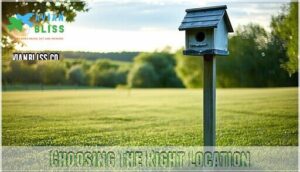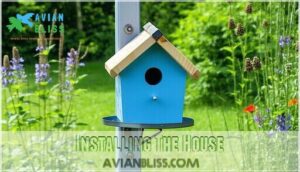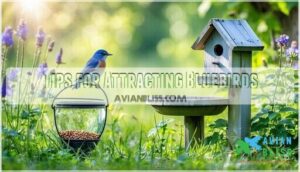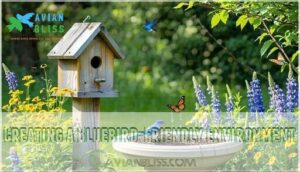This site is supported by our readers. We may earn a commission, at no cost to you, if you purchase through links.
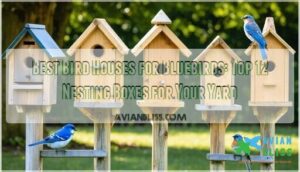
Cedar and pine houses last longest and provide natural insulation.
Mount your house 5-6 feet high in open areas facing away from prevailing winds.
Include ventilation holes, drainage, and predator guards. The roof should overhang to keep rain out, and the entrance hole should have no perch (which attracts competitors).
Remember to clean your birdhouse annually. Eastern Bluebirds need different houses than Mountain or Western species – the subtle differences in design can make all the difference in attracting these jewel-toned visitors.
Table Of Contents
- Key Takeaways
- Choosing Bluebird Houses
- Bluebird House Benefits
- Top 12 Best Bird Houses
- 1. Cedar Bluebird House
- 2. Cedar Birdhouse Assembly Required
- 3. Cedar Blue Bird House
- 4. Bluebird House Cedar Wood Nesting Box
- 5. Bluebird House with Metal Guard
- 6. Bluebird Duplex Bird House Copper Roof
- 7. Cedar Wood Bird House Predator Proof
- 8. Cedar Bird House Copper Guard 2PK
- 9. Durable Blue Bird House Outdoor View
- 10. Waterproof Wooden Blue Bird House
- 11. Recycled Plastic Bird House Bluebird Wren
- 12. XL Bluebird House Nesting Box
- Installing Bluebird Houses
- Attracting Bluebirds
- Frequently Asked Questions (FAQs)
- What is the best birdhouse to attract bluebirds?
- How big should a birdhouse be for a bluebird?
- Do bluebirds need special houses?
- Should you put up a birdhouse for bluebirds?
- Are Audubon Bluebird birdhouses good?
- Does a Bluebird House attract bluebirds?
- What type of Bluebird house should I buy?
- What kind of bird houses do bluebirds prefer?
- Why should bluebird houses face east?
- Which direction should a bluebird house face?
- Conclusion
Key Takeaways
- Choose birdhouses made of durable materials like cedar or pine, with a 1.5-inch entrance hole, ventilation and drainage, and no perches to keep predators and competitors out.
- Install the house 5-6 feet high on a pole with a predator guard, in open spaces facing east or north to attract bluebirds and protect them from bad weather.
- Regularly clean and inspect your bluebird house to remove old nests, check for damage, and ensure it stays safe and inviting for birds.
- Provide mealworms, clean water, and native plants nearby to create a bluebird-friendly environment and support their nesting success.
Choosing Bluebird Houses
When choosing a bluebird house, you’ll want to focus on features that keep them safe and comfortable, like predator guards and proper ventilation.
Durable materials like cedar or weather-resistant options guarantee the box lasts through seasons while meeting bluebirds’ nesting needs.
Features to Consider
When choosing a bluebird house, prioritize features like a 1½-inch entrance size to keep predators out.
Ventilation needs must guarantee proper airflow, while predator guards like baffles offer extra security.
Easy monitoring access, such as side-opening doors, simplifies checks.
A durable birdhouse design with quality materials guarantees longevity, making it a safe and welcoming nesting spot for bluebirds.
Consider appropriate entrance hole sizes for bluebird houses.
Materials and Durability
When picking a bluebird house, choose weather-resistant materials for lasting quality. Cedar offers natural longevity, plywood is affordable and suitable, vinyl is low-maintenance, and stoneware resists damage. Bamboo adds eco-friendly sustainability.
A key aspect is ensuring a 1.5-inch entrance hole to deter larger birds.
For durability, prioritize these options:
- Cedar wood – resists decay.
- Vinyl – easy upkeep.
- Bamboo – renewable.
- Stoneware – withstands harsh weather.
Stay mindful of material benefits!
Predator Protection
Keeping predators out of bluebird houses guarantees birdhouse safety and nesting success.
A predator guard over the entrance stops raccoons and squirrels. Baffle effectiveness increases if poles are smooth and high.
Place nest boxes at the ideal height of 5–6 feet. Monitoring cameras can track activity while helping refine deterrent strategies.
Bluebird protection starts with smart birdhouse predator protection techniques.
Bluebird House Benefits
Bluebird houses provide a safe nesting space, protecting bluebirds from predators and harsh weather. They also help maintain bluebird populations by offering the right conditions for nesting and raising chicks.
Providing a Safe Nesting Environment
A safe bluebird house needs proper ventilation, drainage solutions, and a snug design.
Proper ventilation and drainage create a snug, secure bluebird house, ensuring comfort and safety for nesting success.
Verify box dimensions include at least 1½ inches for the entrance hole. Predator deterrents, like a sturdy predator guard, are essential for predator protection.
Use clean nesting materials for bluebird nesting success. Thoughtful birdhouse design keeps the interior comfortable and secure while protecting against weather and threats, ensuring overall bluebird nesting success.
Attracting Bluebirds to Your Yard
Bluebird attracting starts with creating a welcoming bluebird habitat.
Place bird houses in open spaces with nearby water sources for drinking and bathing.
Supplemental mealworm treats make your yard irresistible.
Plant native plants to provide natural food and shelter.
For winter survival, offer heated water and sturdy bluebird houses for protection.
Blue Jays also enjoy yards with nut-bearing trees.
Thoughtful birdhouse placement guarantees a safe, comfortable spot.
Supporting Bluebird Conservation
Helping bluebirds thrive starts with your backyard.
Choose a bluebird house with supportive features like predator guards and proper ventilation.
Place it strategically in an open area to boost bluebird nesting success.
Monitor your nest box regularly and engage in citizen science efforts.
Habitat preservation, reducing pesticides, and education outreach are all powerful steps toward bluebird conservation.
Top 12 Best Bird Houses
Choosing the right birdhouse can make all the difference for attracting and protecting bluebirds in your yard.
Here are 12 top-quality options, carefully crafted to meet their nesting needs while ensuring safety and durability.
1. Cedar Bluebird House
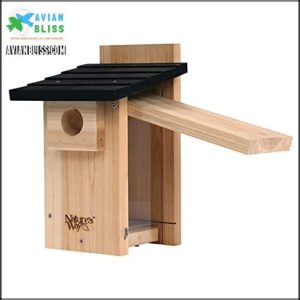
The Cedar Bluebird House is a standout nesting box made from premium rot-resistant cedar.
Its 1½-inch entrance hole is perfect for bluebirds while keeping out larger species.
Air vents and drainage holes guarantee proper ventilation and dryness, making it cozy for birds.
The side door allows easy cleanup, and the elevated mesh floor improves airflow while deterring pesky blowfly larvae.
Crafted for durability, this house handles weather well and lasts for years.
It’s an excellent choice for a safe, comfortable bluebird haven.
Best For: Bluebird enthusiasts seeking a durable, easy-to-clean nesting box that protects birds from predators.
- Crafted from rot-resistant cedar for long-lasting durability.
- Includes predator guard and mesh floor for bird safety and hygiene.
- Easy to install and maintain with no tools required.
- Some units may arrive with minor defects, like roof holes.
- Inadequate shipping packaging can result in damage.
- Designed primarily for bluebirds, limiting use for other bird types.
2. Cedar Birdhouse Assembly Required

If you’re looking for a birdhouse that’s both practical and customizable, the Cedar Birdhouse Assembly Required might be perfect.
This design uses untreated cedar for weather resistance and comes with a stainless steel predator guard to protect nesting birds.
The front door opens for easy cleaning, and interior grooves help fledglings climb out.
Assembly is straightforward with pre-drilled holes and included tools, making it a great family project.
Mount it 4-6 feet high in an open area to attract bluebirds.
Best For: Families or DIY enthusiasts who want a durable, customizable birdhouse that attracts desirable bird species.
- Durable untreated cedar and stainless steel construction.
- Easy assembly with included tools and pre-drilled holes.
- Front door and interior grooves enhance usability for cleaning and fledgling support.
- Ventilation design could be improved for better airflow.
- Requires painting for extended lifespan in harsh weather.
- Higher price point compared to other birdhouses.
3. Cedar Blue Bird House
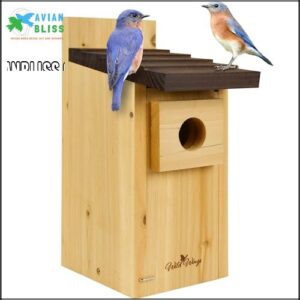
There’s something special about the Cedar Blue Bird House—it blends practicality and charm effortlessly.
Its rough cedar wood design is durable and attractive, ensuring your birds have a safe and comfortable home.
The 1.5-inch entrance keeps predators out, while fledgling skerfs give young birds an easy climb during fledging.
With a front-opening design, cleaning is a breeze, making maintenance quick and hassle-free.
Perfect for pole or flush mounting, this house meets species-specific nesting needs, creating the ideal habitat for bluebirds and tree swallows.
Best For: Bird enthusiasts looking for a durable and easy-to-maintain birdhouse to attract bluebirds and tree swallows.
- Durable cedar wood construction ensures long-lasting use.
- Predator guard and fledgling skerfs provide safety for birds.
- Front-opening design makes cleaning and maintenance simple.
- Occasional issues reported with shipping damage.
- Some users noted the lack of predrilled mounting holes.
- May require additional modifications for specific bird species or environments.
4. Bluebird House Cedar Wood Nesting Box
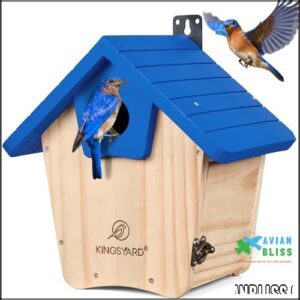
The Bluebird House Cedar Wood Nesting Box is a must-have for any bird-lover’s yard.
Its robust cedar construction resists weather and decay, offering durability for years.
The 1.5-inch entrance hole is perfect for bluebirds, while the predator guard adds extra protection from curious raccoons or cats.
Ventilation holes guarantee proper airflow, keeping the interior comfortable, especially during warm seasons.
Plus, cleaning is effortless with the flip-down front panel, and this box provides a safe space, helping bluebirds thrive in your backyard.
Best For: Bird enthusiasts and nature lovers who want a durable, easy-to-clean birdhouse that attracts bluebirds and other small birds.
- Requires a smooth pole with baffle for optimal predator protection.
- Exterior may need occasional treatment with non-toxic stain or linseed oil.
- Limited to small bird species with a 1.5-inch entrance hole.
- Sturdy cedar construction resists weather and decay.
- Predator guard ensures added safety for nesting birds.
- Easy-to-clean flip-down front panel simplifies maintenance.
5. Bluebird House with Metal Guard
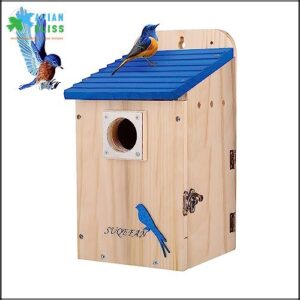
The Bluebird House with Metal Guard is perfect for protecting your feathered friends from predators like cats and snakes.
It features a strong metal predator guard at the entrance, guaranteeing safe nesting for bluebirds and their chicks.
Designed with proper ventilation, drainage, and weather-resistant materials, this box keeps bluebirds comfortable year-round.
The durable construction ensures longevity, while its thoughtful design prevents predators from harming the nest, providing safe nesting and peace of mind for the bluebirds.
If you’re looking for a reliable option to protect bluebirds, this house delivers safety.
Best For: Nature lovers, bird enthusiasts, and families seeking a safe and durable nesting solution for bluebirds.
- Limited to bluebirds and similar small bird species.
- Requires installation near specific locations for optimal results.
- May not fit larger bird species or non-standard birdhouse sizes.
- Features a strong metal predator guard for safety.
- Built with weather-resistant materials for year-round comfort.
- Designed with proper ventilation and drainage for a healthy environment.
6. Bluebird Duplex Bird House Copper Roof
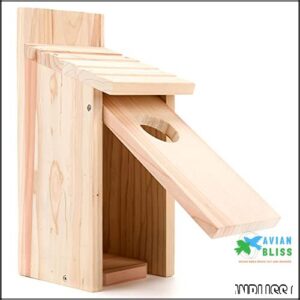
For years, the Bluebird Duplex Bird House with Copper Roof has been a favorite among bird enthusiasts.
This two-compartment house features a slanted copper roof that extends beyond the main body, ensuring excellent water drainage and protection from the elements.
Made from natural wood with a polished surface, it provides a comfortable home for bluebirds and wrens.
The round window design prevents predators while allowing proper air circulation.
It’s easy to install with the hanging hole at the top, and the clean-out feature makes maintenance simple.
This attractive duplex mounts perfectly on a 4×4 post.
Best For: Nature enthusiasts looking to provide a safe, durable, and attractive home for bluebirds and wrens.
- Durable slanted copper roof ensures protection from weather.
- Easy to install with a hanging hole or 4×4 post compatibility.
- Clean-out feature simplifies maintenance for repeated use.
- Higher-end models can be expensive, with prices up to $1,295.00.
- Some models may require backordering, causing delays.
- 4×4 post needed for installation is not included.
7. Cedar Wood Bird House Predator Proof

Throughout your yard, this Cedar Wood Bird House provides exceptional protection for nesting bluebirds.
Crafted from robust cedar that naturally resists weather and insects, this house features a predator-proof entry hole (1 3/8") that keeps birds safe while ensuring good airflow.
The built-in predator guard prevents raccoons and cats from reaching inside, while wooden toggle closures on doors enhance security.
With dimensions of 10"W x 6"D x 8.5"H, it offers ample space for bluebirds and similar species.
The side panel opens for easy cleaning and monitoring of nesting progress.
Best For: Homeowners or bird enthusiasts seeking a durable, predator-proof birdhouse for bluebirds and similar species.
- Sturdy cedar construction naturally resists weather and insects.
- Predator-proof design with guard and secure closures.
- Easy to clean with a convenient side-opening panel.
- Requires a specific mounting post for installation.
- Limited size, suitable primarily for small bird species.
- Entry hole may not accommodate larger bird types.
8. Cedar Bird House Copper Guard 2PK
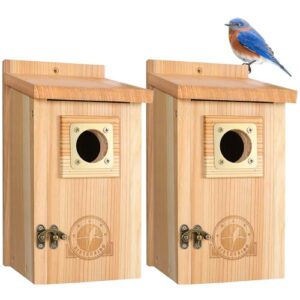
With the Cedar Bird House Copper Guard 2PK, you’re getting double the protection for your neighborhood bluebirds.
These houses feature 1-1/2" entrance holes that welcome bluebirds, wrens, chickadees, and tree swallows while keeping European starlings out.
Made from untreated cedar with a rough surface, they provide birds with good footholds and natural weather resistance.
The copper predator guards add extra protection, while interior grooves help fledglings safely exit.
Ventilation holes also facilitate proper airflow.
Maintenance is simple thanks to front-opening doors for easy cleaning.
When nesting season ends, just clean them out and save for next spring.
Best For: Backyard bird enthusiasts looking to attract bluebirds, wrens, chickadees, and tree swallows while deterring predators like European starlings.
- Made from durable, untreated cedar with weather resistance.
- Copper predator guards provide extra protection for young birds.
- Front-opening doors make cleaning and maintenance easy.
- Assembly is required, which may not suit everyone.
- Only available in a two-pack, limiting options for single purchases.
- Untreated wood may require additional care in certain climates.
9. Durable Blue Bird House Outdoor View
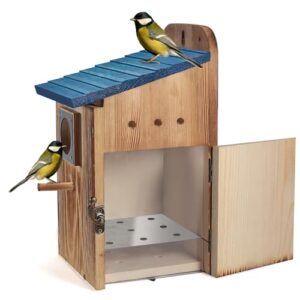
Monitoring nesting activities becomes a breeze with this durable bluebird house featuring a clear viewing panel.
Built from 3/4" thick treated premium pine with a burnt finish, this house offers both style and protection.
The copper predator guard surrounding the entrance hole keeps threats at bay while you observe birds through the transparent side window without disturbing them.
It arrives fully assembled with dimensions of 5.4"D x 5.4"W x 10.3"H, making it ready to hang immediately, and the elevated mesh floor provides additional protection against blowflies, creating a safe, comfortable environment for your feathered visitors.
Best For: Bird-watching enthusiasts, bluebird conservationists, and anyone looking to enhance their garden decor.
- Limited size may not accommodate larger bird species.
- Requires proper placement to avoid unwanted predators.
- Burnt finish may not appeal to all aesthetic preferences.
- Durable construction with predator-proof copper guard for bird safety.
- Clear viewing panel for unobtrusive bird observation.
- Arrives fully assembled, ready to hang and use immediately.
10. Waterproof Wooden Blue Bird House
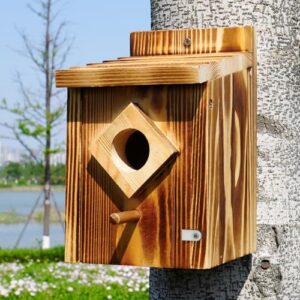
Protect your feathered friends with this high-quality waterproof wooden bluebird house.
Treated with special paint to prevent cracking, this handcrafted cedar nest box measures 11" high x 5½" deep x 4" wide inside, creating a cozy habitat. You’ll appreciate the front door that opens for easy cleaning and maintenance.
With its 1.5-inch diameter entrance hole and rod-shaped perch, this house attracts bluebirds, wrens, chickadees, and tree swallows. No assembly required—just mount it and watch birds move in.
Drainage holes guarantee proper water management, making this durable house ideal for any outdoor setting, providing a perfect place for your feathered friends.
Best For: Nature enthusiasts and bird lovers looking for a durable and easy-to-maintain birdhouse to attract bluebirds and other small bird species.
- Made of durable, handcrafted cedar with waterproof treatment.
- No assembly required and includes an easy-to-open front door for cleaning.
- Features a 1.5-inch entrance hole and perch, ideal for bluebirds, chickadees, and wrens.
- Smaller size may not suit larger bird species.
- Requires careful placement to avoid predators.
- Protector square does not reliably deter sparrows.
11. Recycled Plastic Bird House Bluebird Wren

This eco-friendly recycled plastic bird house offers durability that wooden houses simply can’t match.
Measuring 6 x 6 x 8.5 inches, it’s perfectly sized for bluebirds and wrens with its 1.5-inch entrance hole and metal predator guard.
You’ll appreciate the thoughtful design features – enhanced ventilation, front-opening door for easy cleaning, and weather-resistant construction that won’t dent, crack, or warp over time.
Users love the sturdy composite deck board material and customization options, while some report minor assembly issues with the logo plate, this vibrant blue house stands ready to welcome feathered residents year-round.
Best For: Bird enthusiasts looking for a durable, weather-resistant, and easy-to-clean birdhouse for bluebirds and wrens.
- Minor logo plate assembly issue that may require adjustment.
- Potential delay in attracting bird residents.
- Not all included features may support larger bird species.
- Sturdy construction from recycled composite deck board material.
- Weather-resistant design prevents cracking, denting, or warping.
- Easy-to-clean front-opening door and customizable assembly.
12. XL Bluebird House Nesting Box
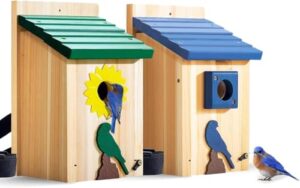
Within the domain of premium bluebird housing, this XL Nesting Box stands out with its generous 5" x 5.5" floor size—perfect for Eastern Bluebirds.
Made from untreated cedar with thick 13/16" walls, it offers superior protection and durability. The double roof design prevents overheating, while recessed floors keep nests dry during rainstorms.
Each package includes two houses, complete with tree banding kits, mounting screws, and a screwdriver for easy setup. The upward-angled vent holes and openable door add practical functionality.
Available in blue or green UV-protected finishes that last for years.
Best For: Bluebird enthusiasts looking for a durable, spacious, and weather-resistant nesting box with user-friendly features.
- Made from untreated cedar with thick walls for strength and insulation.
- Double roof design and recessed floor ensure bird comfort in varying weather.
- Comes with all necessary components for assembly and installation.
- Assembly takes approximately 45 minutes per birdhouse, which may be time-consuming.
- Mixed customer feedback on the inclusion of sufficient screws in the package.
- Optional sealant needed to fully waterproof certain gaps.
Installing Bluebird Houses
You’ll need to position your bluebird house 5-6 feet above ground on a metal pole with a predator guard, facing east or north in an open area at least 300 feet from other nest boxes.
Once mounted, regular monitoring through the side-opening door will help guarantee successful nesting while minimizing disturbance to your feathered tenants.
Choosing The Right Location
Now that you’ve selected your bluebird house, finding the perfect spot will make all the difference in attracting these beautiful birds. Bluebirds are particular about their real estate location.
The perfect bluebird house location creates harmony—open space, proper height, and predator protection ensure a safe, inviting nesting haven.
For successful bluebird nesting, remember these placement fundamentals:
- Choose open areas with short grass, ideally 100-300 feet from trees
- Position houses 250-300 feet apart to respect territorial behaviors
- Face entrance holes eastward, away from prevailing winds
Mount your bluebird house 5-10 feet high on a smooth pole to guarantee proper habitat considerations while maintaining predator avoidance.
Installing The House
Once you’ve selected the perfect location, let’s get your bluebird house properly installed.
The mounting height should be 5-6 feet on a pole, with proper spacing houses at least 300 feet apart to prevent territorial disputes.
Make sure directional facing is east or north to avoid afternoon heat.
Always add predator baffles to the mounting pole to keep raccoons away. Consider using a specialized mounting pole for ideal stability.
For successful birdhouse installation, use the proper hardware for a secure, no-wobble fit.
Maintenance and Repair
With your bluebird house securely mounted, regular maintenance guarantees it remains a welcoming home for years.
Clean your birdhouse at least once annually, preferably before spring nesting season. Remove old nests and debris to reduce parasites.
Inspect for wood rot, loose screws, or damaged predator guards during cleaning sessions. Consider purchasing maintenance supplies to help with this task.
For repairs, use weather-resistant materials compatible with your birdhouse’s construction. A well-maintained birdhouse substantially improves its durability and attractiveness to bluebirds.
Attracting Bluebirds
You’ll find success attracting bluebirds to your yard by combining proper NABS-approved housing with consistent fresh water sources and supplemental food like mealworms.
Bluebirds prefer open grassy areas with natural perches for hunting insects, so position your houses away from wooded areas and at least 300 feet apart to prevent territorial conflicts.
Tips for Attracting Bluebirds
Now that your bluebird house is properly installed, you’ll want to attract these beautiful birds to their new home.
Offer live or dried mealworms in a specialized bluebird feeder—they’re absolute favorites! Provide fresh water in a shallow bath year-round, including heated options for winter survival.
Install natural perches 10-15 feet from the house for hunting spots. Create grassy open spaces nearby and consider adding leaf misters in summer.
Regular nest monitoring helps support bluebird conservation efforts.
Protecting Bluebirds From Predators
Now that you’ve attracted bluebirds to your yard, keeping them safe is your next challenge.
Predators like raccoons, cats, and house sparrows threaten nesting success.
Here are three effective predator protection strategies:
- Install proper predator guards with appropriate entrance hole size
- Mount nest boxes on smooth poles with baffles
- Position boxes away from trees where predators can jump
Regular monitoring of nest boxes helps identify threats before they become problems. Your vigilance creates a safe haven for these beautiful birds.
Creating a Bluebird-Friendly Environment
Creating a bluebird-friendly backyard starts with open, grassy spaces where these birds can hunt insects.
Plant native plants that attract natural food sources. Add water sources like bird baths with shallow edges.
Provide winter shelter and nesting materials such as pine needles nearby. Good insect control comes naturally with bluebirds around.
Remember, your bluebird house needs proper ventilation, drainage, and a predator guard for complete protection. To truly entice them, consider that mealworms are a favorite.
Frequently Asked Questions (FAQs)
What is the best birdhouse to attract bluebirds?
You’ll want a NABS-approved cedar house with a 1½-inch entrance hole, proper ventilation, and easy-clean access.
The CWH4 design offers these features plus predator guards and mesh flooring for your feathered friends.
How big should a birdhouse be for a bluebird?
The most spectacular bluebird house needs a 4×4 inch floor space with a 12-inch height. You’ll want a 1½ inch entrance hole about 6 inches above the floor for ideal nesting conditions.
Do bluebirds need special houses?
Yes, bluebirds do need special houses. They require specific dimensions, entrance hole sizes, and features like proper ventilation, drainage holes, and predator guards to successfully nest and raise their young.
Should you put up a birdhouse for bluebirds?
You’ll benefit from putting up a bluebird house.
These beautiful birds need specific nesting requirements that standard birdhouses don’t provide.
With the right house, you’ll enjoy watching bluebirds raise their families nearby.
Are Audubon Bluebird birdhouses good?
Like a cedar sanctuary in your yard, Audubon Bluebird houses stand strong with high ratings from customers.
You’ll appreciate their durable construction, proper ventilation, and easy-clean front panels that keep your feathered friends safe and comfortable.
Does a Bluebird House attract bluebirds?
Properly designed bluebird houses definitely attract bluebirds when placed in open grassy areas.
You’ll need the right entrance hole size (1½ inches), proper ventilation, and positioning away from wooded areas to successfully welcome these beautiful visitors.
What type of Bluebird house should I buy?
Choose a cedar bluebird house with a 1½-inch entrance hole and proper ventilation.
Look for side-opening doors for easy monitoring, predator guards for safety, and a forward-slanting roof to keep the interior dry.
What kind of bird houses do bluebirds prefer?
Bluebirds adore roomy wooden houses with predator guards, breathable ventilation, and rain-shedding roofs.
They prefer entrances sized perfectly for their safety—about 1½ inches.
Place them in open spaces, facing away from busy foliage or predators.
Why should bluebird houses face east?
Facing bluebird houses east shields nests from harsh afternoon heat and weather, while welcoming morning sunlight.
This setup keeps the box more comfortable, encourages activity early, and provides an ideal environment for raising young birds, which is crucial for their development.
Which direction should a bluebird house face?
Aim your bluebird house east or north.
These directions shield nests from harsh sun and rain while staying cool and dry.
This setup mimics natural spaces bluebirds prefer, improving their chances of nesting successfully.
Conclusion
A well-chosen bluebird house symbolizes hope for these vibrant birds and their future.
By providing the best bird houses for bluebirds—offering proper dimensions, durable materials, and essential features like predator guards and ventilation—you create a safe haven for nesting.
Placement matters too; an open area shields them from threats.
Annual cleaning also guarantees a fresh start each season.
These small steps support conservation, attract bluebirds, and offer you the joy of watching these "jewel-toned visitors" thrive.



